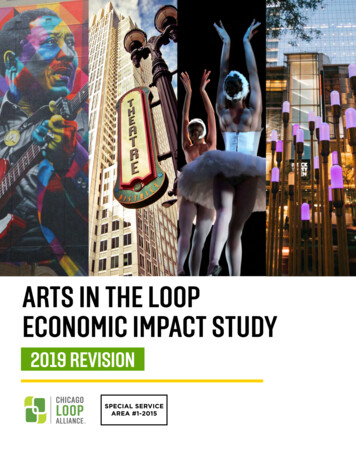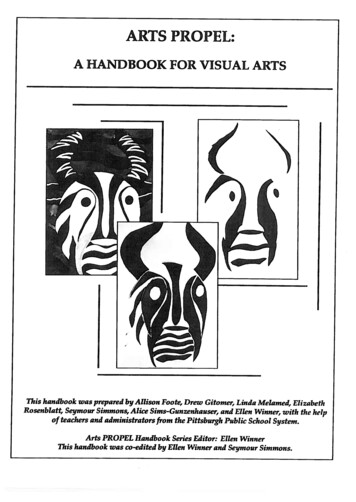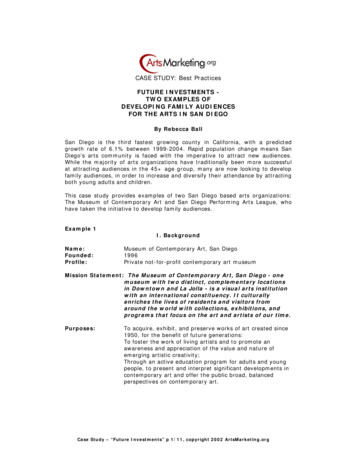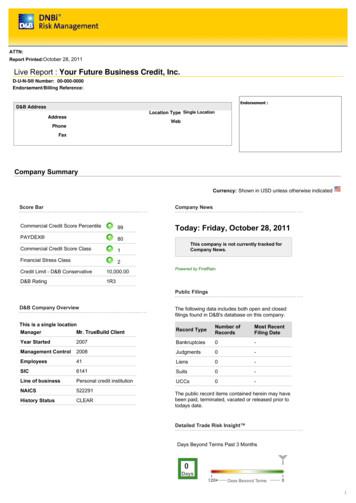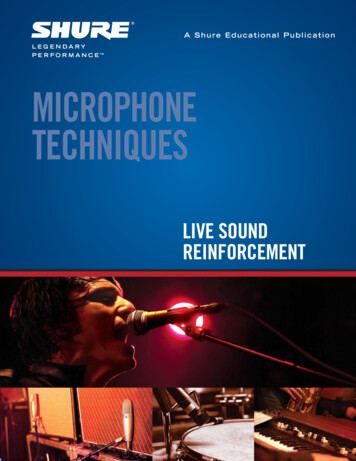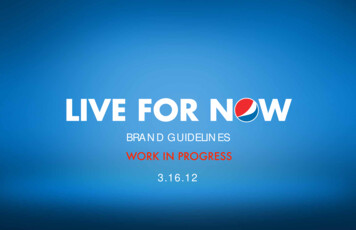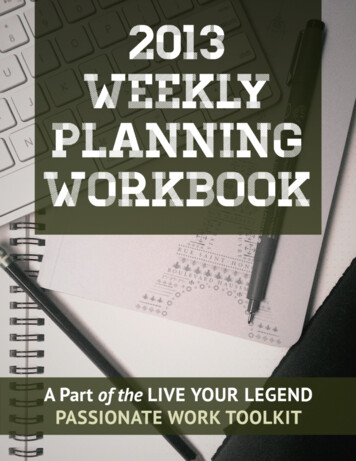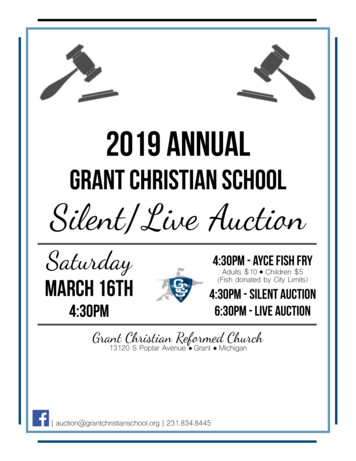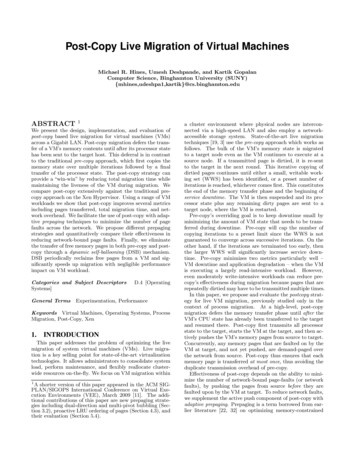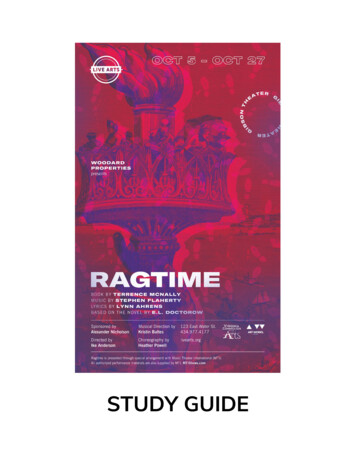
Transcription
STUDY GUIDE
And everything was Ragtime.This sweeping musical portrait of early-twentieth-century America tellsthe story of three families in pursuit of the American Dream.Written by the award-winning composer/lyricist team of Stephen Flaherty and LynnAhrens ( Once on This Island, Seussical, and Lucky Stiff ), and noted playwrightTerrence McNally, and based on E.L. Doctorow's distinguished novel, R agtime is thewinner of the 1998 Tony Awards for Best Score, Book and Orchestrations, and boththe Drama Desk and Outer Critics Circle Awards for Best Musical and Best Score.At the dawn of a new century, everything is changing, and anything is possible. Setin the volatile melting pot of turn-of-the-century New York, three distinctly Americantales are woven together: that of a stifled upper-class wife, a determined Jewishimmigrant, and a daring young Harlem musician. They are united by their courage,compassion, and belief in the promise of the future. Together they confront history'stimeless contradictions of wealth and poverty, freedom and prejudice, hope anddespair, and what it means to live in America.Ragtime Study Guide Compiled by the Live Arts Ragtime Dramaturgy teamShelby Marie Edwards, Geri Schirmer, and Michael SwanbergWith contributions from and editing by Education Director Miller Murray Susenwith assistance from Live Arts Intern Alicia Zheng1
Table of ContentsFull Synopsis .Pg. 3Act OneAct TwoRagtime Historical Who’s Who .Pg. 7From the Live Arts Ragtime Dramaturgical Team Pg.10At A GlanceRagtime African-American Aesthetic References Line by LineJewish Immigration to America2
Full SynopsisAct OneWe are introduced to the social and political climate of the United States in the earlytwentieth century by meeting a parade of characters – famous celebrities andprivate citizens of the time. First, we visit New Rochelle, New York, to meet awell-to-do white family: Mother, Father, their Little Boy, Mother's Younger Brotherand Grandfather. Next, we go to Harlem to meet Coalhouse Walker, Jr., a ragtimepianist, and his admirers. Immigrants arrive at Ellis Island, where we meet Tateh, anartist who makes silhouettes, and his Little Girl. The lives of these three Americanfamilies are entwined with Booker T. Washington, Harry Houdini, J.P. Morgan, HenryFord, Evelyn Nesbit, and Emma Goldman. Whites, African Americans, immigrants,and celebrities are set on a collision course from the opening number ("Ragtime").Father is accompanying Admiral Peary on a trip to the North Pole. At the dock, heconsoles Mother that everything will be the same upon his return, but Mother is notconvinced ("Goodbye My Love"). On its way out of the harbor, Father's ship passes arag ship filled with immigrants, arriving in New York. Tateh and the Little Girl are onboard. Tateh and Father wave to one another; Father admires the immigrants fortheir naive bravery in coming to a new land, and Tateh questions Father's reasonsfor leaving the place that he has worked so hard to find. Simultaneously, Motherwonders what this year without her husband will bring ("Journey On").Mother's Younger Brother is in love with Evelyn Nesbit. He is frustrated and lost,searching for meaning in his life and hoping to find it in her. Her show is a vaudevilleact that tells the true story of her lover's murder by her famous husband ("Crime ofthe Century"). Younger Brother goes to all of her shows. One day, after the show,Younger Brother approaches her, but she dismisses him.The scene shifts to Mother and the Little Boy in the garden. The Little Boy wants tosee Houdini, as he has a cryptic message for him: "Warn the duke." While shebegins to read her Father's letter, mother makes a shocking discovery – there is anewborn African-American child buried in the flowerbed. The police arrive on thepremises with Sarah, the mother of the child. Rather than let Sarah go to prison,Mother takes Sarah and the child into her own home ("What Kind of Woman").With many other immigrants, Tateh and The Little Girl disembark at Ellis Island, fullof hope ("America"). Tateh sets up his business on the Lower East Side, selling papersilhouettes of celebrities for a nickel each. Emma Goldman chastises him for sellingone of J.P. Morgan, the epitome of capitalism. J.P. Morgan enters the scene andmetaphorically crushes the immigrants, but Harry Houdini magically swoops in asan emblem of immigrant triumph. Time passes, Tateh becomes less idealistic – he isstill poor and the Little Girl is sick. When a man tries to buy the Little Girl, Tateh has3
reached rock bottom. He swears to make a better life for himself and his child("Success").Far Uptown, the people of Harlem celebrate the great musician, Coalhouse Walker,Jr. ("His Name Was Coalhouse Walker"). He tells his friends the story of how heloved and lost Sarah, but reveals that he's just found out where she might be livingand is determined to win her back ("Getting' Ready Rag"). Henry Ford appears to tellus of his new method of mass production and his most famous product – the ModelT ("Henry Ford"). A new car rolls off of the assembly line, and Coalhouse drives off insearch of Sarah.Back in New Rochelle, Mother and the Little Boy wait at the train station, on theirway to New York City to take care of the family business while Father is away.Tateh and the Little Girl wait across the tracks for a train to Boston. Mother andTateh greet one another, and Tateh is surprised to be treated with respect ("NothingLike the City"). The Little Boy has a premonition that they will see Tateh and theLittle Girl again, but Mother tells him that is absurd.On his way to New Rochelle, Coalhouse encounters a group of hostile volunteerfiremen who threaten him for being cocky by driving past them in his new car.Meanwhile, Sarah, living in Mother's attic, begs her infant's forgiveness for herdesperation – trying to explain what drove her to such an unimaginable act ("YourDaddy's Son"). When Coalhouse arrives at Mother's home, Sarah will not see him.Coalhouse returns every Sunday for weeks, wooing Sarah with his ragtime tunesand winning over Mother, Grandfather and the Little Boy ("The Courtship"). Fatherreturns from the North Pole to find a very different household from the one he left.He cannot wrap his head around the facts that his wife is independent, his family isaccepting of the African-American courtship happening in his living room and thereis ragtime music coming from his piano ("New Music").Finally, Sarah comes down to see Coalhouse and they reunite. Coalhouse tells Sarahof his admiration for Booker T. Washington's achievements and, together, he andSarah imagine a future for their child ("Wheels of a Dream"). Meanwhile, inLawrence, Massachusetts, Tateh has lost sight of the American dream and nowworks at a mill 64 hours a week. In Union Square, Emma Goldman tries to generatea strike against the oppressive mill owners. Younger Brother happens to hear herspeech and is energized to the cause of workers rights – he finally has something inwhich to believe ("The Night That Goldman Spoke in Union Square").A violent labor strike erupts in Lawrence. Tateh intends to put The Little Girl on atrain to a safer place, with other children and a chaperone. However, she is sodistraught that he jumps on the train with her. He soothes her terror with a flipbookof silhouettes that he has made ("Gliding"). The train conductor notices the book ofmoving silhouettes and buys it for his own child. Tateh sees this as a wonderful new4
business idea.Coalhouse once again encounters the volunteer firemen, and, this time, they do morethan threaten him. As Booker T. Washington gives a speech about rising above andholding fast, the men destroy Coalhouse's car. Coalhouse moves through the legalchannels in search of justice for this crime against him, but he is denied at everyavenue ("Justice"). He postpones his marriage to Sarah until the matter is resolved.Sarah, out of desperation and naiveté, tries to seek help from a visiting VicePresidential candidate but is clubbed to death by police, who suspect her of havinga gun ("President"). Act One closes with the anger and grief of Sarah's funeral ("TillWe Reach That Day").Act TwoCoalhouse mourns the loss of Sarah ("Coalhouse's Soliloquy"). Seeking vengeance,he shoots three of the firemen who trashed his car, burns their firehouse anddemands that the fire chief, Willy Conklin, be brought to justice ("CoalhouseDemands").A group of young men joins Coalhouse as he strikes out against the system. BookerT. Washington publicly condemns Coalhouse's actions. Father goes to the police totell them what he knows about Coalhouse. Younger Brother, who is moved by theplight of the oppressed and angry about the injustice done to Coalhouse, erupts atFather for working against Coalhouse. He storms out of the house in anger, andMother, who is still caring for Sarah and Coalhouse's baby, is deeply upset. Inreaction, Father takes the Little Boy to a baseball game. But even this has changedand is now a game, not just for upper class whites, but for immigrants, too ("What aGame"). Meanwhile, Coalhouse's band of men sets fires around the city. Reportersbesiege the family in New Rochelle. Father, thinking that it is time to get away, takesthe family to Atlantic City, where Evelyn Nesbit and Houdini both happen to bestarring attractions ("Let's Run Away to Atlantic City").In Atlantic City, we discover that Tateh is now a famous film director and hasrecreated himself as Baron Ashkenazy. His daughter, healthy and beautifullydressed, is by his side. Once again, Tateh meets Mother and tells her the story of hissuccess ("Buffalo Nickel Photoplay, Inc.").Later, the Little Boy asks Houdini for his autograph and gives him the message:"Warn the duke." Houdini is confused and intrigued, but the Little Boy runs off. TheLittle Girl and Little Boy play together as Tateh and Mother watch from theboardwalk ("Our Children"). Tateh reveals his humble origins to Mother, who ismoved by his honesty.In Harlem, Younger Brother searches for Coalhouse and, although the residents aredistrustful of him, one of Coalhouse's men takes him to Coalhouse's hideout.5
Meanwhile, drawn by laughter and dancing in a club, Coalhouse thinks of the firsttime that he met Sarah ("Sarah Brown Eyes"). A blindfolded Younger Brother isbrought to Coalhouse's den. Younger Brother wants to express his sympathy forCoalhouse's actions but all he can manage to do is offer his knowledge of explosives("He Wanted to Say"). Coalhouse focuses his rage by taking over J.P. Morgan'sLibrary. He threatens to blow up the library and all of its treasures, as well as himselfand all of his men, one of whom is now Younger Brother. Father tells Mother that hehas volunteered to act as a negotiator, and Mother realizes that this experience hasirrevocably changed their relationship ("Back to Before").Coalhouse and his men barricade themselves inside the library. Emma Goldmanapplauds this, but Booker T. Washington deplores these actions. Father tells theauthorities that Booker T. Washington is the only man to whom Coalhouse willlisten. Booker T. is sent into the library to speak with Coalhouse. He chidesCoalhouse, both for risking the lives of the young men around him, while leaving hisown son to be raised by white men, and for endangering the position of all AfricanAmericans by making them seem hot-headed and violent ("Look What You'veDone"). He assures Coalhouse that, if he surrenders, he will have a fair trial and aforum for his opinions. Coalhouse negotiates the safe passage of his men, includingYounger Brother, while Father remains behind in the library. The men protest hisdecision, but he explains to them that the only way to win the fight is to go out intothe world and tell their story ("Make Them Hear You"). When Coalhouse is left alonewith Father, he asks about his son. Father promises a safe end to the standoff, but,when Coalhouse exits the building to surrender, he is shot dead by authorities.The era of ragtime ends. The characters come forward, one by one, to tell us the endof their stories: Younger Brother joins the revolutionary Emiliano Zapata, EmmaGoldman is deported, Booker T. Washington establishes the Tuskegee Institute,Evelyn Nesbit fades into obscurity, Houdini has the one true mystical experience ofhis life when he is performing in Sarajevo and the duke is shot, Grandfather dies andFather is killed during wartime. Finally, Mother and Tateh marry and move toCalifornia with their children.As the curtain falls, Little Coalhouse runs into Mother's arms, and men and womenof all nationalities – and races – join Mother on the stage ("Epilogue").Source: https://www.mtishows.com/ragtime-version-16
Ragtime H istorical Who’s WhoHenry FordJuly 30, 1863 – April 7, 1947The American founder of the Ford Motor Company and father of modern assemblylines used in mass production. His introduction of the Model T automobilerevolutionized transportation and American industry. He was a prolific inventor andwas awarded 161 U.S. patents.Matthew HensonAugust 6, 1866 – March 9, 1955An African American explorer and associate of Robert Peary during variousexpeditions, the most famous being a 1909 expedition which claimed to be the firstto reach the Geographic North Pole.Harry HoudiniMarch 24, 1874 – October 31, 1926,born Ehrich WeissA Jewish-Hungarian-American magician and escapologist, stunt performer, actorand film producer, as well as a skeptic and investigator of spiritualists.J.P. MorganApril 17, 1837 – March 31, 1913An American financier, banker and art collector who dominated corporate financeand industrial consolidation during his time. He is widely credited with having savedor rescued the U.S. national economy in general—and the federal government inparticular—on two separate occasions. He bequeathed much of his large artcollection to the Metropolitan Museum of Art in New York City and to th
desperation – trying to explain what drove her to such an unimaginable act ("Your Daddy's Son"). When Coalhouse arrives at Mother's home, Sarah will not see him. Coalhouse returns every Sunday for weeks, wooing Sarah with his ragtime tunes and winning over Mother, Grandfather and the Little Boy ("The Courtship"). Father
